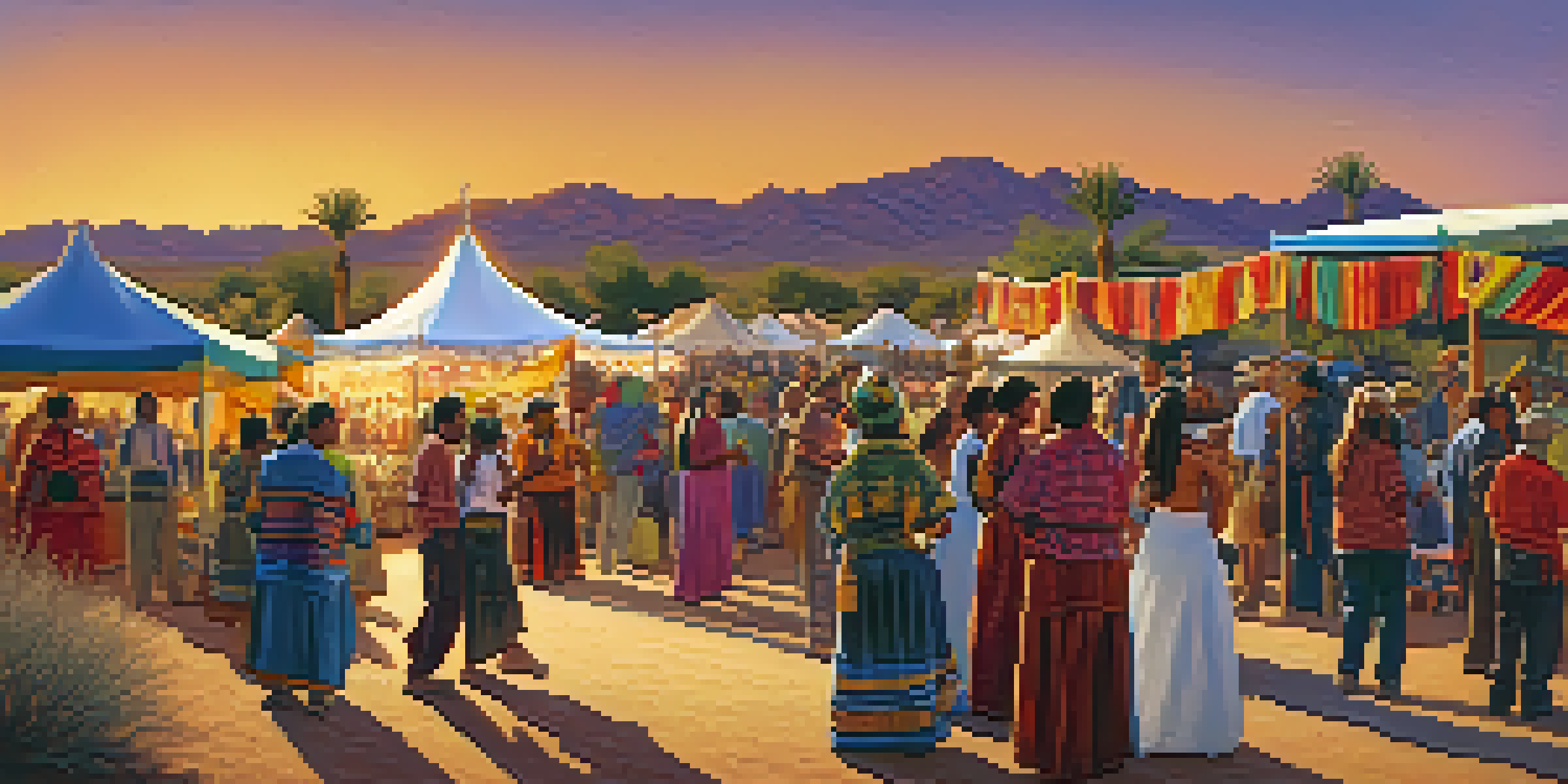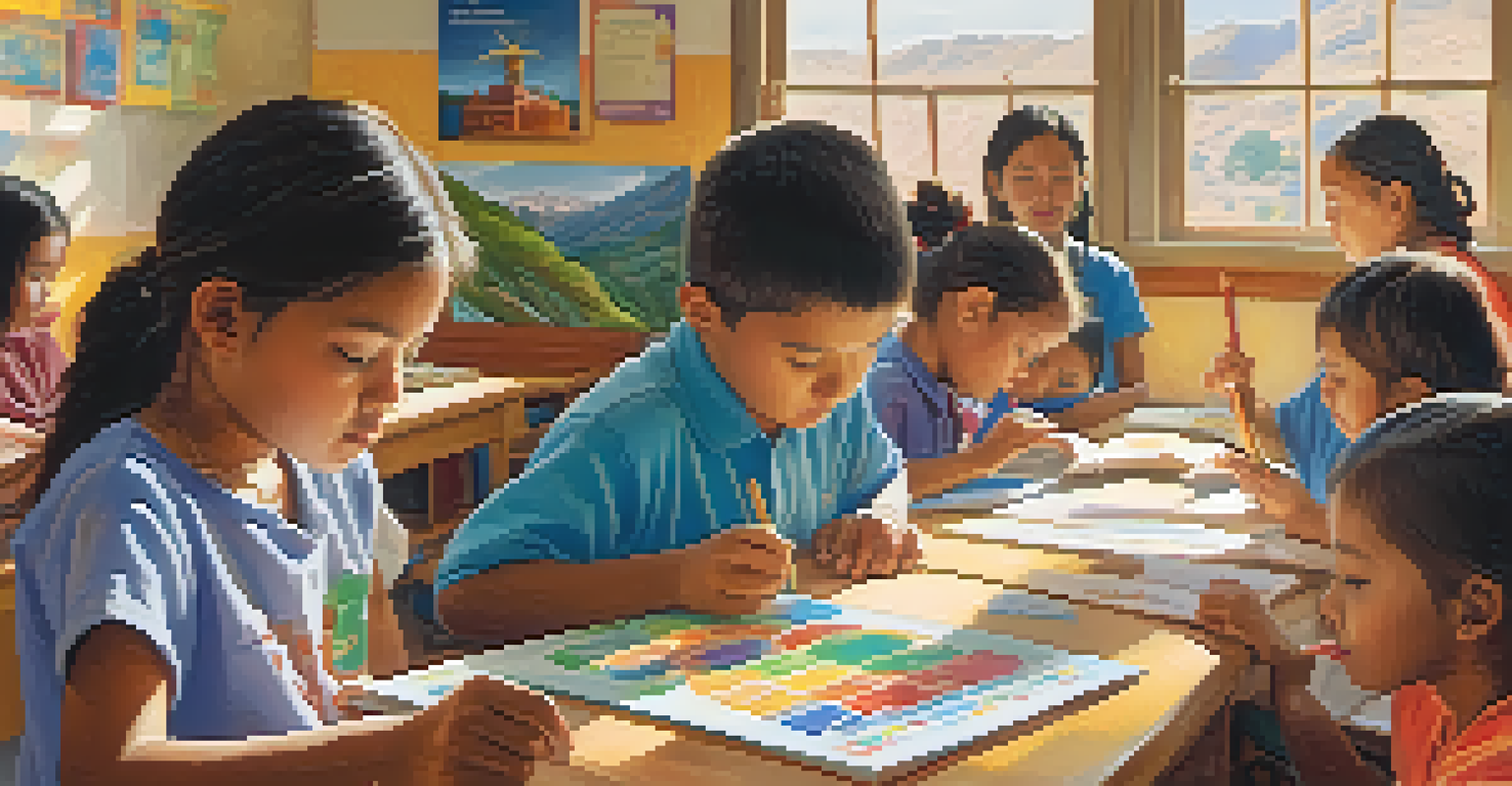The O'odham Language: History and Significance in Tucson

Understanding the O'odham Language and Its Roots
The O'odham language, also known as O'odham or Papago, is a vital part of the Tohono O'odham Nation. This language is not just a means of communication; it embodies the culture, traditions, and identity of its speakers. Originating from the Uto-Aztecan language family, it has unique phonetic and grammatical features that reflect the community's connection to their land.
Language is the road map of a culture. It tells you where its people come from and where they are going.
Historically, the O'odham people have inhabited the Sonoran Desert for centuries, and their language has evolved alongside their experiences. With a rich oral tradition, O'odham stories and songs are passed down through generations, often featuring the natural world, spirituality, and tribal history. This oral transmission has helped preserve the language despite various challenges over the years.
The significance of the O'odham language goes beyond mere words. It serves as a bridge to understanding the worldview of the O'odham people, connecting them to their ancestors and the environment. As such, revitalizing and preserving the language is crucial for maintaining cultural heritage.
Historical Challenges Faced by the O'odham Language
The O'odham language has faced numerous challenges throughout history, particularly during the colonization period. Spanish and later English settlers imposed their languages and cultures, often marginalizing native tongues, including O'odham. This led to a decline in the number of fluent speakers and a shift towards English in many communities.

In the 20th century, government policies further exacerbated the decline of the O'odham language. Assimilation efforts, including boarding schools, aimed to eradicate indigenous languages and cultures. Many O'odham children were punished for speaking their native language, contributing to a generational gap in language transmission.
O'odham Language's Cultural Importance
The O'odham language serves as a vital vessel of cultural identity, connecting speakers to their heritage and traditions.
Despite these challenges, the O'odham community has shown resilience. Grassroots movements and cultural revitalization programs have emerged, encouraging younger generations to learn and speak O'odham. This renewed interest is essential in reversing the language decline and ensuring its future.
Current Efforts in O'odham Language Revitalization
Today, there are vibrant efforts underway to revitalize the O'odham language, especially within educational settings. Language immersion programs in schools are helping to teach young O'odham children their native tongue, focusing on everyday vocabulary and cultural context. These programs aim to foster a sense of pride and identity among the youth.
To be rooted is perhaps the most important and least recognized need of the human spirit.
Community workshops and language classes are also being organized to engage adults and elders in the learning process. These gatherings not only teach the language but also serve as social events that strengthen community bonds. By practicing together, participants are able to share stories and traditions, further embedding the language into their daily lives.
Additionally, the use of technology plays a crucial role in language preservation. Online resources, mobile apps, and social media platforms are being utilized to create engaging content that showcases O'odham language and culture. This modern approach helps to reach a wider audience and encourages younger generations to connect with their roots.
Cultural Significance of the O'odham Language
The O'odham language is more than just a method of communication; it is a vessel of cultural identity. Each word carries stories and meanings that are deeply tied to the O'odham way of life, including their connection to the land, nature, and spiritual beliefs. The language reflects a worldview that emphasizes harmony with the environment, which is integral to O'odham culture.
Traditional practices, such as storytelling, ceremonies, and songs, are often conducted in O'odham, highlighting the language's role in cultural expression. These practices not only entertain but also educate, imparting lessons and values that are vital to the community's identity. As a result, preserving the language is essential for maintaining these cultural practices.
Revitalization Efforts in Education
Current initiatives focus on language immersion programs and community workshops to engage younger generations in learning O'odham.
Moreover, the revitalization of the O'odham language fosters a sense of pride and unity among the community members. As people learn and use their language, they reconnect with their heritage and strengthen their cultural bonds. This collective effort promotes resilience and a shared identity, which is crucial for the community's future.
The Role of O'odham in Tucson's Cultural Landscape
Tucson, Arizona, is a hub of cultural diversity and is home to a significant O'odham population. The city's rich tapestry of cultures is reflected in its festivals, art, and local businesses, many of which incorporate O'odham language and traditions. This blending of cultures not only enriches Tucson but also raises awareness about the O'odham community's history and contributions.
Local museums and cultural centers often host events and exhibits that celebrate O'odham heritage, showcasing artifacts, art, and oral histories. These initiatives provide opportunities for both O'odham and non-O'odham residents to learn about the language and culture, fostering mutual respect and understanding. By engaging the broader community, the significance of the O'odham language is highlighted.
Tucson's educational institutions are also playing a part in promoting the O'odham language. Collaborations with the Tohono O'odham Nation have led to the inclusion of O'odham studies in school curricula. This educational approach not only empowers O'odham students but also informs non-O'odham students about the importance of preserving indigenous languages.
Challenges Ahead for the O'odham Language
Despite the progress made in revitalizing the O'odham language, challenges remain. One significant hurdle is the ongoing generational gap, as many fluent speakers are aging and younger generations may not be as proficient. This gap can hinder the transmission of linguistic knowledge and cultural practices, making it crucial to find innovative ways to engage youth.
Another challenge is the influence of dominant languages, such as English and Spanish, which continue to permeate daily life in Tucson and the surrounding areas. As these languages dominate media and social interactions, the O'odham language may struggle to find its place in modern contexts. Efforts must be made to create spaces where O'odham can thrive alongside other languages.
Challenges for O'odham's Future
Despite revitalization progress, challenges like generational gaps and the dominance of English threaten the ongoing use of the O'odham language.
Finally, securing funding and resources for language programs is essential for sustainability. While community initiatives have shown promise, ongoing support from both local and national organizations is needed to ensure that these programs can continue to flourish. Addressing these challenges is vital for the future of the O'odham language and culture.
The Future of the O'odham Language and Community
Looking ahead, the future of the O'odham language depends on the collective efforts of the community and its allies. By fostering an environment that values and promotes the language, the O'odham people can strengthen their cultural identity and ensure that their language endures. This requires commitment from both the community and educational institutions to prioritize O'odham in curricula and programming.
The integration of modern technology and social media can also play a pivotal role in engaging younger audiences. Creating content that resonates with youth—like music, videos, and interactive learning tools—can spark interest and encourage language use. As younger generations become more involved, they can bring fresh perspectives and creativity to language preservation efforts.

Ultimately, the O'odham language is a vital thread in the cultural fabric of Tucson and beyond. By embracing the language and its significance, not only does the O'odham community flourish, but it also enriches the cultural landscape for all who call Tucson home. Together, the community can ensure that the O'odham language continues to thrive for generations to come.